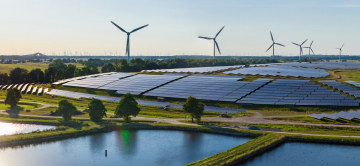For the first time since its creation by the NOME law in 2010, the mechanism that gives electricity suppliers access to energy produced by EDF’s nuclear power plants has reached its legal ceiling of 100TWh per year for 2019. This record demand shows signs of causing major tensions in the electricity market.
Access to production capacities
How do we introduce competition into an industry dominated by an incumbent operator? The radical solution consists in breaking up such an operator into separate pieces that will be sold to independent operators. Two iconic examples of this are Standard Oil (1911) in the oil industry and AT&T (1983) in telephony. However, when the incumbent operator uses a technology deemed sensitive to national security, the solution of breaking it up is not politically acceptable. This is the case for the nuclear power plants owned by EDF. It is difficult to envisage how the ownership of such assets could be dispersed. Nevertheless, we can share out its production flow. This solution was chosen by the European Commission in February 2001 when it authorised the takeover by EDF of the German operator EnBW, subject to EDF putting part of its electricity production up for sale on the French wholesale market over a minimum period of five years, based on drawing rights for which the strike price reflected the variable cost of its plants.[1] This mechanism to make electricity available with the aim of mitigating the effects of market concentration was deemed to be encouraging by the European Commission.[2] It is therefore logical that the Champsaur Commission, made responsible in 2008 by the French government for suggesting solutions for moving forward in the liberalisation of the electricity market, proposed the idea of Regulated Access to Incumbent Nuclear Electricity (Accès Régulé à l'Electricité Nucléaire Historique - ARENH), a mechanism introduced by the NOME law in 2010.[3]
The ARENH mechanism
Under the terms of the law, from 1 July 2011 until 31 December 2025, EDF’s rival suppliers can buy electricity produced by EDF’s nuclear power plants located in France and commissioned before 8 December 2010 (this is the ‘H’ in ARENH for ‘Historique’, incumbent in English). Total ARENH volumes sold each year should not exceed 100TWh (aside from making up losses to network operators), i.e. around 25% of the production of the incumbent's nuclear generating capacity. The subscribed quantities are based on forecasts made by suppliers of the consumption of their customers residing in France for the following year. This mechanism is also locked in terms of price since all subscribers pay for their purchases based on a regulated tariff, currently €42/MWh. The objective is therefore to put all suppliers on a level footing with EDF when they buy wholesale energy to sell it retail.
Arbitrage risks
The common rules that govern exchanges within the European Union grant the right to trade freely. There is therefore a risk of seeing volumes subscribed under ARENH diverted for uses other than consumer sales appearing in purchasers’ portfolios. To avoid opportunistic behaviour and reduce forecasting errors, the regulatory texts depart from common law by introducing penalties, two price supplements calculated based on prices observed on the wholesale markets. The first addition regularises the discrepancy noted in relation to the market price in the event of resale of ARENH volumes on the wholesale market. It is restored to EDF since this diversion of use runs contrary to the very spirit of the regulation’s mechanism. The second represents a contractual penalty in the event of excessive demand from a supplier. It is broken down between subscribers. We shall return to this later.
These two supplements are intended to offset errors and opportunism on the part of suppliers. However, there is still room for strategic choices since a 10% margin of error is accepted for the second penalty. Furthermore, a penalised supplier may pass on the additional price to some of its customers’ invoices, as a way of sharing out the risks.
Changes in subscriptions
The table below shows the changes in demand for ARENH (in TWh) since the mechanism was put in place.[4]
|
2011 (H2) |
2012 |
2013 |
2014 |
2015 |
2016 |
2017 |
2018 |
|
30.9 |
60.8 |
64.3 |
71.4 |
16.1 |
0 |
82.1 |
96.4 |
The collapse in 2015 and 2016 is explained by the fall in prices on the electricity markets where suppliers were able to make their purchases at a price well under €42. Since 2017, ARENH subscriptions have gone up in parallel with the recovery in wholesale market prices. For 2019, the Energy Regulation Commission (Commission de Régulation de l'Energie - CRE) has received a total demand of 132.93TWh (November 2018 press release). Since the legislative ceiling sets the annual quantity to be transferred at 100TWh, the CRE has divided it up pro rata to subscription requests.
This distribution of the shortfall is far from efficient. In fact, we can expect suppliers to incorporate the rule of proportional rationing in their future requests and so inflate their subscriptions as soon as they see potential price increases on other sources of supply. The allocation of drawing rights could be improved by arranging a two-round system such that i) nothing is changed if total demand does not reach the 100TWh ceiling, otherwise ii) the CRE organises an auction revealing what subscribers are willing to pay, with surplus revenues thus generated being allocated at the legislator’s discretion.
Let us consider the following example taken from the CRE's 2018 report (page 40): two suppliers, A and B, have a customer portfolio that gives them each a theoretical right to 60TWh. If they subscribe "honestly" to ARENH, as the sum of their requests exceeds 100TWh, they are rationed pro rata to their request and so each receives 100*(60/(60+60))=50TWh. However, if A anticipates this rationing whereas B sticks to its policy of honesty, by stating a requirement for 90TWh supplier A obtains 100*(90/(90+60))=60TWh, which only leaves B with 40TWh. As the quantity received by A corresponds to its theoretical right, it does not incur any penalty (having not exceeded the tolerance of 10%) and B feels aggrieved. At least, this is the viewpoint of the CRE, which is seeking a mechanism that allows the rights of B to be restored. In fact, so long as we do not know how much the two parties are willing to pay, we cannot distinguish whether their behaviour is good or bad in terms of economic efficiency. If, for example, A reckons on selling to its customers at a price of €44/MWh (excluding transport and taxes) and B at a price of €43, it is effective to ration B and to satisfy A’s request in full. A bidding round in which applicants state their maximum quantity and the price they are willing to pay would trigger this mechanism. The competitive equilibrium price of ARENH would be set at around €43, at the point where stepwise decreasing aggregate demand meets the fixed supply of 100TWh. With this allocation, any difference between the equilibrium price and the regulatory €42 represents a substantial profit since it has to be multiplied by 100 million MWh. You can bet that the public authorities would not be short of ideas on how to use it.
*
* *
An institutional innovator always expects a lot from what it creates. By making ARENH a limited and temporary mechanism, the legislator intended to encourage alternative suppliers to find means of supply in addition to production from installed nuclear power plants. The facts show that this is far from being the case. Suppliers benefit opportunistically from this windfall without investing in production assets, outside subsidised renewable energies. Maybe, with the 2025 deadline approaching, we shall see an increase in supply contracts binding EDF and suppliers that do not own any production assets, a soft form of investment.
[1] This system was identified by the term Virtual Power Plants (VPP); see http://www.ausubel.com/auction-papers/ausubel-cramton-vpp-auctions.pdf. Today we use VPP to refer to the aggregation of small diverse power plants managed by a single operator.
[2] "Energy sector competition inquiry" (10 January 2007) http://europa.eu/rapid/press-release_MEMO-07-15_fr.htm?locale=en
[3] Law no. 2010-1488 of 7 December 2010 relating to the new organisation of the electricity market (so-called "NOME" law).
[4] CRE source "Evaluation of the ARENH mechanism between 2011 and 2017", https://www.cre.fr/Documents/Publications/Rapports-thematiques/Rapport-ARENH





